(捷进英语1)Unit6-电子教案
Unit6-电子教案

(捷进英语2)U n i t6-电子教案(共5页)--本页仅作为文档封面,使用时请直接删除即可----内页可以根据需求调整合适字体及大小--教案课程名称捷进英语综合教程2课时班级专业教师系部教研室教材《捷进英语综合教程2 教师用书》Sense and memoryImproving your memoryPerfect memories?Reading for learningSense and memoryReading for DoingDon’t Forget!Guided WritingA QuestionnaireAudio/Video LabIf you have time before the lesson youcould prepare your own timeline to displayto the class.This section startswith identifyingexamples andusing them tohelp the studentunderstand thetext. It alsoencouragesstudents toproduce a briefsummary of thetext.Vocabulary andGrammarThe first two tasks work on the meaning of thematic words from the text. Task 3 looks at various fixed phrases from the text. The grammar section looks at the passive voice in the present and past simple.The first two tasks encourage students to form an understanding of examples. When doing Task 4, if you have a strong class you could simply write the three headings on the board and ask students to write their own summary sentences.The first vocabulary tasks draw on topic vocabulary from the text.The second vocabulary task can be easily extended by asking students to give written or spoken answers to each question.The Grammar Focus part looks at the passive voice in the present and past simple. Task 2 contains factually true sentences. You could extend this by asking students to write their own general knowledge quiz in the passive voice. The topic in Task 3 can also be extended into a discussion task.Beyond the text This section also recycles the passive in a fun way by creating realBeyond the Text Students look at two puzzles and write their own puzzle.Ss read an article giving advice on improving your memory.This section should take less time than section B as the texts are less complicated. They focus on developing students’ everyday reading skills.If you have more time, you could develop the final task on revision planning and strategies further.Students write, ask and answer a questionnaire.Before the lesson you could find examples of questionnaires online.When doing Task 5 you might need to provide some model questions for more support.For each part of the video you might want to play it twice.Tasks 3 provides a good opportunity for using visuals to help you understand a lecture.This section provides a quick review of the vocabulary, grammar, writing and theme of the unit.Tasks could be set for individual work or done in pairs. For the first tasks on the language work you might want to set them up as a team game or class quiz.For the final tasks these could be set as small group discussion or down as a reflective writing task.Finish all the tasks in Unit 6.Read the two texts in this unit again and try to summarise their contents.Prepare a PPT presentation on your survey result in Task 3 of the warp-up section.。
捷进英语语音 初级版 Lesson 6 第二课时 教案本
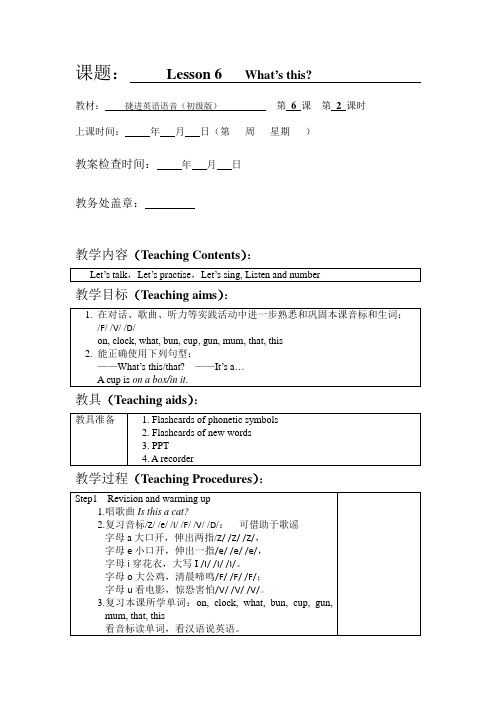
教师反复表演几次,然后,出示文字让学生翻译,并两人一组进行表演。
老师可用身边的实物告诉学生this与that的区别:分别表示近指、远指。
2.学习Let’spractise
该部分两段内容在结构上相似,但难度上有分化。第二段中含有介宾结构。本部分可用实物导入,以第二部分为例:
3.复习本课所学单词:on, clock, what, bun, cup, gun, mum, that, this
看音标读单词,看汉语说英语。
Step 2 Presentation
1.学习Let’s talk
可用简笔画导入本部分两段内容,以第一段为例:
教师画一个外国小男孩坐在餐桌边,他在和一家中国人对话,教师可以分别扮演两个角色,指着桌上的一个馒头进行问答:
课题:Lesson6What’s this?
教材:捷进英语语音(初级版)第6课第2课时
上课时间:年月日(第周星期)
教案检查时间:年月日
教务处盖章:
教学内容(Teaching Contents):
Let’s talk,Let’s practise,Let’ssing, Listen and number
Step 4 Summary and homework
1.句型:What’s this/that? It’s a… A cup ison a box/in it.
2.音标/Z/ /e/ /I/ /F/ /V/ /D/,单词:on, clock, what, bun, cup, gun, mum, that, this。
1.唱歌曲Is this a cat?
2.复习音标/Z/ /e/ /I/ /F/ /V/ /D/:可借助于歌谣
Unit1Lesson6教案
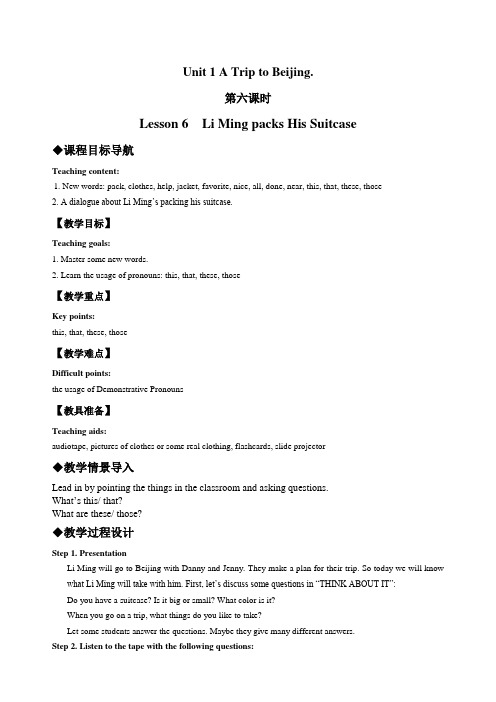
Unit 1 A Trip to Beijing.第六课时Lesson 6 Li Ming packs His Suitcase◆课程目标导航Teaching content:1. New words: pack, clothes, help, jacket, favorite, nice, all, done, near, this, that, these, those2. A dialogue about Li Ming’s packing his suitcase.【教学目标】Teaching goals:1. Master some new words.2. Learn the usage of pronouns: this, that, these, those【教学重点】Key points:this, that, these, those【教学难点】Difficult points:the usage of Demonstrative Pronouns【教具准备】Teaching aids:audiotape, pictures of clothes or some real clothing, flashcards, slide projector◆教学情景导入Lead in by pointing the things in the classroom and asking questions.What’s this/ that?What are these/ those?◆教学过程设计Step 1. PresentationLi Ming will go to Beijing with Danny and Jenny. They make a plan for their trip. So today we will know what Li Ming will take with him. First, let’s discuss some questions in “THINK ABOUT IT”:Do you have a suitcase? Is it big or small? What color is it?When you go on a trip, what things do you like to take?Let some students answer the questions. Maybe they give many different answers.Step 2. Listen to the tape with the following questions:What does Li Ming need?Does Li Ming take only one shirt?Step 3. Answer the questions and look through the whole text.Deal with some language points (using flash cards and slide projector). Make sure the students understand the meaning of the dialogue.Step 4. Play the audiotape again and let the students read after it.Step 5. PracticeLet the students read the text aloud and the teacher walks around and deals with any question the students have. Then have them act out the dialogue in roles (using pictures or real clothes). Correct their mistakes if any.Step 6. Let’s chantListen to the recorder first and then read it together. Pay attention to the rhyme: far and star; near and ear;these and knees; those, toes and know. If you read in the right rhyme, you will read it beautifully. Write “this, that, these, those” on the blackboard or use slide projector. Explain the difference between these words.◆课堂板书设计作业Homework:1. Finish the activity book in Lesson 6.2. Read the text fluently.3. Read the next reading in Lesson 7.课后巩固练习阅读理解。
(捷进英语1)Unit1-电子教案
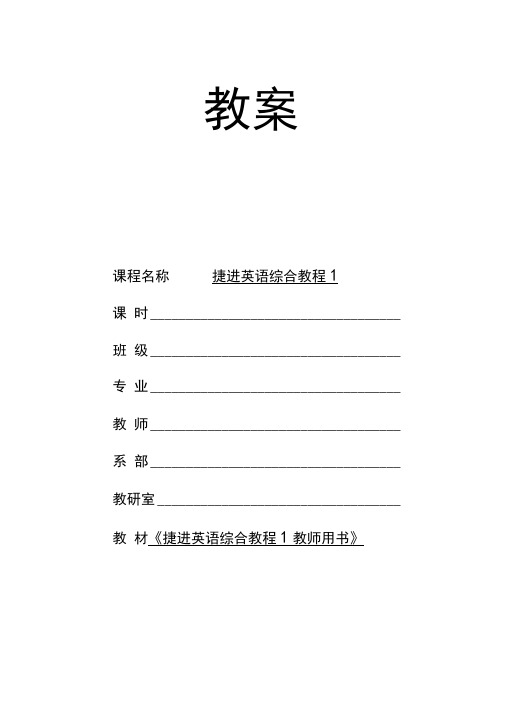
(阅读)
Reading for doing
Students read posters describing activities and clubs around campus.
Students create their own club.
This section should take less time than the text in Reading for learning as the text is shorter. However, there is some challenging vocabulary in some of the posters. They focus on developing students everyday reading skills and it leads into a mini productive writing task.
Before completing Task 2 you could elicit the punctuation rules students have already known.
With weaker students you might want work through an example in Task 3.
英语1 unit6 教案
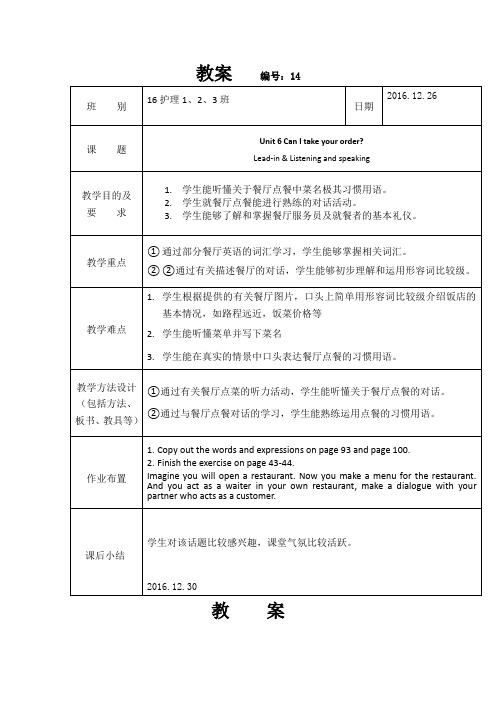
教案编号:14教案(3)What about …restaurant ?(4)I think …Restaurant is better. It’s farther away than …, but the food is more delicious.2. Listen and repeatRead the dialogue after the tape again and learn to say the underlined words and sentences.3. Practice and talkTeacher shows another picture which is similar to the one of Activity 3.Students work in the group to describe the picture in simple several sentences, which is similar to those of Activity 5, then make a dialogue with the partner according to the picture.Step Five Listening1. Pre-listening ( Activity 7 )(1) Read the menuTeacher says: we have our favorite foods when we eat out . In the last lesson we have known that there are two restaurants. Now Sara want to go Meiwei Restaurant. Let’s step into Meiwei restaurants with her together to order something to eat or drink today. Now let’s look at the menu of Meiwei Restaurant to find out if there are any foods you like....Teacher says: But do you knowWhat a waiter/waitree might say?What might the customer say?Welcome to our restaurant.Are you ready to order? / Would you like to order now?What would you like to eat?Would you like something to drink?What about you?Pardon? / Can you say it again?...Yes, I’d like... / No, thanks...., please.What’s the specialty of the house?Let’s go dutch....(2) Look and tickTeacher leads students to look at the two pictures and let them guess what thewaiter might say, then tick the right answers.2. While-listening ( Activity 8, 9 )(1) Listen and checkStudents listen to the tape and check the answers to Activity 7.(2) Listen and completeStudents listen to the dialogue again and help the waiter finish the notes he makes about what Sara and Tang Hua order. If students can’t get the answers, teacher should play the tape for several times to help them to get the right answers.3. post-listeningFill the words of the blanks to complete the listening material. Later, Teacher divides the whole class into two groups to read out as waiter, Sara and Tang Hua .Waiter: Would you like to _______ now?Sara: Yes. I’d like ______ ______.Waiter: Well done or __________?Sara: Well done, please.Waiter: Would you like something _____ _________?Sara: A glass of orange juice, please.Waiter: Beef steak well done and a glass of orange juice.Sara: Right.Waiter: _______ _______ you, Miss?Tang Hua: ________ _______, please.Waiter: All right. _______ ____ _______, please.Step Six Speaking1. Read and underline (Activity 10)Students underline the words and sentences used to order in a restaurant. Teacher asks several students to give the answers and write the words or sentences on the board. If necessary, teacher should explain the key words and sentences.(1) Would you like to order now?(2) Yes, I’d like ……(3) Well done or medium(4) Would you like something to drink?(5) What about you?(6) The same, please.(7) All right, wait a minute, please.....2. Listen and repeat (Activity 11)Students read the dialogue after the tape again and learn to say the underlined words and sentences.3. Act and practiceStudents make a dialogue with the partner about ordering food in a restaurant, using the sentences patterns and words listed on the blackboard. One student acts as a waiter, the other acts as a customer. Firstly, they work together in their groups. Secondly, teacher lets some of them教案编号:15教案。
Unit6-电子教案
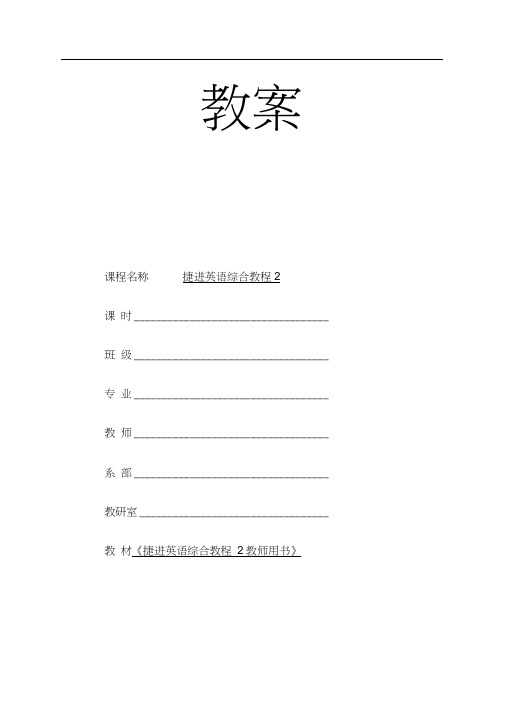
write the three headings on
the stude nt
the board and ask students
for
un dersta nd
to write their own summary
lear ning
the text. It
senten ces.
also
The first vocabulary tasks
教案
课程名称捷进英语综合教程2
课 时பைடு நூலகம்
班 级
专 业
教 师
系 部
教研室
教 材《捷进英语综合教程2教师用书》
Teach ing Plan
教学
单元
Un it6In My Mi nd
单元
主题
Sense and memory
Impro ving your memory
Perfect memories
课
时安
排
8
教 学 内 容
tasks work on
in the prese nt and past
the meaning of
simple. Task 2 contains
thematic words
电子教案第一册U6-1.doc
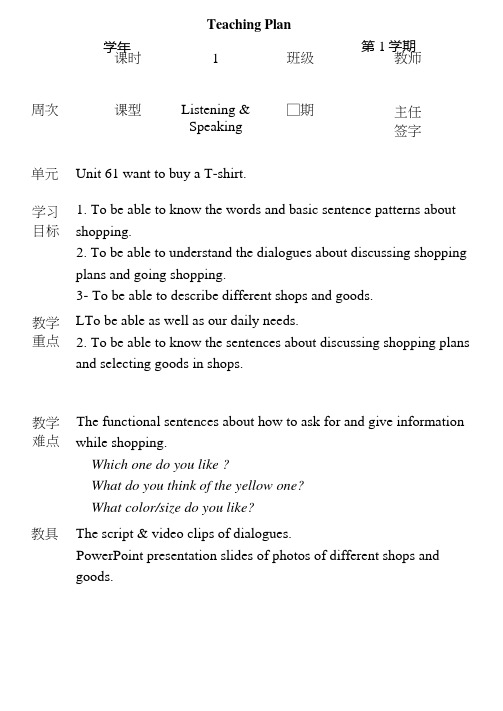
课时 1 班级 教师 周次课型 Listening & Speaking □期 主任 签字 单元Unit 61 want to buy a T-shirt. 学习目标1. To be able to know the words and basic sentence patterns about shopping.2. To be able to understand the dialogues about discussing shopping plans and going shopping. 3- To be able to describe different shops and goods. 教学重点LTo be able as well as our daily needs. 2. To be able to know the sentences about discussing shopping plans and selecting goods in shops. 教学难点The functional sentences about how to ask for and give information while shopping. Which one do you like ? What do you think of the yellow one? What color/size do you like? 教具 The script & video clips of dialogues.PowerPoint presentation slides of photos of different shops and goods. Teaching Plan学年 第1学期教学环节设计9 c 9 n t s 9 n Asnit6hth①plaibouordeedss 1•JnCtxpa wnent b ・m ・lc•刃 e p • c k ,八jppee 赵mlse6m o ②©wo)u deshothtth"•伽thetothgentsttyctuctufoanviatntska^oo,eyts"spaseentvit.pl.pldca )rtvhde)oT//?kenw meys.LldctsdQe.llneV howuclo牝―hedokngstuAwmthm stss o C6/r tL fl s e ・m nels 11 sasnw「r^/cee)rgthaheirNp enttudwthhem伽炯duthwominentmektingthesenassheseshokt•^•ItroayareseirASothithprechhatprthI.sas/I.InIT.Akewpr-svclwiVI.suwListening & Speaking practice(l) I.Ask the students to try reading aloud the words in the word box on Page 61. Then ask them to read them after the tape.II.Show the picture of a shopping list- Tell the students they are going to listen to a short dialogue about a shopping list. Give them some advice onlistening for the key words on the shopping list. III.Play the tape twice and ask the students to practice it after the tape・ Present the key words on theshopping list.IV.P resent the basic sentences on the blackboard: / want to buy a T-shirt and a school bag.Dad needs some shampoo.Let's make a shopping list.V.Ask the students to listen to the dialogue again. And then ask them to form into groups and make dialogues with the given words in Activity ③.VI.Group work.Give four groups different topics and ask them to prepare a shopping list according to the four topics: Thanksgiving Day, A week,s tour at seaside, A visit to a school at the mountain village, A class party.Listening & Speaking practice(2) I. Ask the students to look at the pictures of the three T-shirts on Page 62, and ask them three questions and present them on the slide: Which one do you like? What do you think of...? How about...? II. A sk the students to listen to the dialogue in Activity ④,and find out what Sam wants to buy. III. Ask the students to listen to the dialogue in Activity ④ again. Then ask them to work in pairs and act out the dialogues in Activity ⑤. IV. Group work: design some goods in different colours or sizes on a piece of paper. Then promote your group's to other groups. Consolidati onL Divide students into groups for different shops- Help students find anything available in the classroom to be their goods. II. Give two students from every group TOO yuan 59 and ask them to be the “customers” to buy anything they like from other groups- The goup members left should be the "seller^ to promote their sale. Summary Key words and phrases:toothbrush towel soap chip bright shopping list shampoo go shoppingKey sentence patterns:Which one do you like?What do you think of that yellow one? 教学环节设计Homework 1 • Ask the students to read the dialogues.2.Ask the students to memorise the key words,phrases and sentence patterns.3.Ask the students to make a shopping list for theirfamilies on this weekend・。
(捷进英语1)Unit6-电子教案
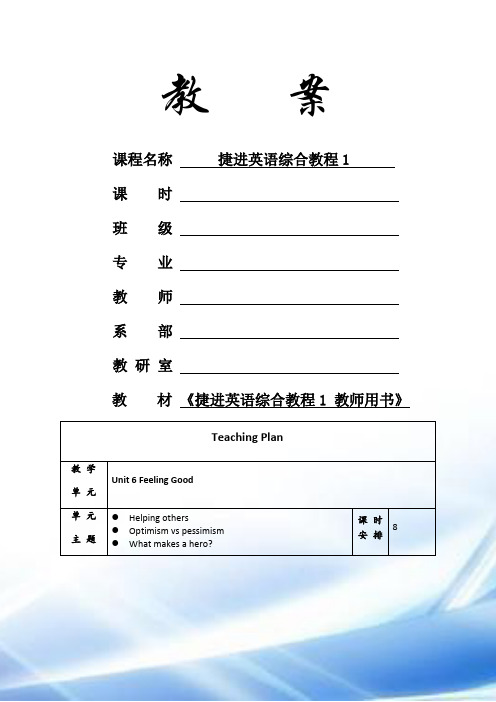
教案课程名称捷进英语综合教程1课时班级专业教师系部教研室教材《捷进英语综合教程1 教师用书》Teaching Plan教学单元Unit 6 Feeling Good单元主题●Helping others●Optimism vs pessimism●What makes a hero?课时安排8教学内容●Reading for learningWould You Like to Make a Difference?●Reading for DoingHalf Full or Half Empty?●Guided WritingA Letter of Thanks●Audio/Video Lab教学环节主要特色教学活动安排建议Warm-up(热身)This section introducesthe idea of feelings andreactions. It does thisthrough a set ofadjectives and musicclips for students toreact to.✧Depending on the time you have available,you could extend this into students playingtheir own music and discussing how themusic makes them feel.Reading (阅读)Readingforlearning◆This section startswith usingpronoun referentswhen reading tohelp understandthe organisation ofa text. It thenencouragesstudents to workout reasons in thetext.◆Vocabulary andGrammarStudents look atphrases and individualwords from the text.The grammar focus✧In Task 4 of Reading and Understanding,you could ask students to compare theirtranslations with a partner. Then ask studentsto close their books and translate them backinto English.✧In Vocabulary Focus, the three vocabularytasks draw on the text. Task 1 and Task 3 arealso a set of questions and so work well aspair-work discussion tasks.✧The Grammar Focus part looks at differentways of referring to the past, present andfuture with quite simple structures. Afterworking through the tasks you would setstudents a short written or spoken task usingthese structures to refer to their own desiresin the past present and future.✧Beyond the Text encourages students to reactlooks at would like to, like to and wanted to.◆Beyond the TextStudents interpret their own decisions. personally to the texts they have read. It also practices the grammar structure. Students could also think about and discuss their own good deeds.Reading for doing ◆Students read andanswer aquestionnaire onoptimism andpessimism.✧This section should take less time thansection A as the text is less complicated.They focus on developing students’ everydayreading skills as they are reading andresponding to a questionnaire.✧If time permits, students could create theirown scenario and options for others tochoose as an additional question in thequestionnaire.Guided Writing ◆Writing a letter ofthanks:(1) Formal expressionsof thanks(2) Informalexpressions ofthanks ✧When checking Task, 2 you could highlightsome of the other features of informality aswell as the vocabulary / phrases focused on,e.g. the punctuation and contractions.✧With weaker students you might want toshow them the model first before they writetheir email.Audio/Video Lab ◆Students watch avideo showingan interviewwith someonewho has donesomethingheroic:(1) making predictions(2) dictating andansweringquestions ✧Write hero onto the board and ask students todefine the word and to think of an example of one.✧When you get to Task 5, you will probablyneed to pause briefly between each question.Wrap-up ◆This sectionprovides a quickreview of thevocabulary,grammar, writing ✧For Task 1, Task 2 and Task 3 on thelanguage work, you might want to set themup as a team game or class quiz.✧For Task 4, it could be set as small groupand theme of theunit.◆Tasks could be setfor individualwork or done inpairs.discussion task.课后学习设计作业◆Finish all the exercises in Unit 6.◆Read the two texts in this unit again and try to summarisetheir contents.◆Write a letter of thanks to a person who ever helped you.课后总结和反思。
第一册Unit6_Section C教学设计

Unit 6 TravelSection C Travel in Bangkok曼谷之旅I.Analysis and Design of the Teaching Material 教材分析与教学设计本课题型为reading(阅读课),教学内容是省编英语新教材第一册第6单元Section C Travel in Bangkok,主要介绍泰国首都曼谷的地理位置及最知名的景点。
通过阅读,带领学生走进泰国,了解异国他乡的风土人情,拓宽学生的视野;同时,通过略读、细读等形式培养学生的阅读技巧,提高学生的阅读能力。
整节课的设计以教师作为一名导游,带领课堂上的学生(游客)进行一次旅行为主线,层层深入,趣味性十足。
第一步骤是课堂小调查(寻觅你的旅行足迹)。
通过课前欣赏教师本人假期旅行的照片,引导学生回想自己的旅行足迹,引出话题。
紧接着以一段视频为导入,让学生猜猜今天大家去哪里,吊足学生胃口。
第三步,神秘城市(曼谷)浮出水面;游客在地图上明确旅行城市的地理位置。
第四步围绕文章展开。
但是,作者并没有采用传统的阅读课形式,而是以导游(教师)的行程安排为线索,融入听、读、说多种形式。
首先让游客简单浏览宣传单(文章),明确本次旅行的主题以及依次参观的景点。
紧接着,游客到达第一站—感受曼谷佛教精神,了解曼谷的特色佛教建筑。
第二站—体验“东方威尼斯”,来到曼谷的水上市场,走走看看,了解风土人情;要是喜欢,还可以带些当地特色食物回家。
第三站—享受金色沙滩(夜晚之旅)。
回到家,学生都兴奋不已,向家人、朋友讲述自己的所见所闻,其实质是让学生对某个景点的一个回顾以及概述。
这样的巧妙处理,就显得富有趣味性。
第五步,将旅游的娱乐性上升到一个精神层面,通过小组活动,引导学生爱护旅游资源,争当文明游客。
第六步,以快速抢答的形式,学生积极总结曼谷的地理位置、天气、知名景点等,对整节课进行总结。
II.Analysis of the Students本册教材针对职业类学校的高一学生。
捷进英语 Unit 6
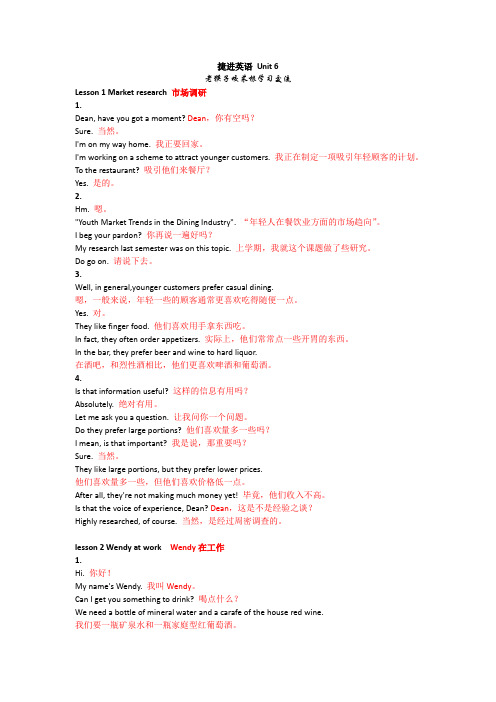
捷进英语Unit 6老猴子咬菜根学习交流Lesson 1 Market research 市场调研1.Dean, have you got a moment? Dean,你有空吗?Sure. 当然。
I'm on my way home. 我正要回家。
I'm working on a scheme to attract younger customers. 我正在制定一项吸引年轻顾客的计划。
To the restaurant?吸引他们来餐厅?Yes. 是的。
2.Hm. 嗯。
"Youth Market Trends in the Dining Industry". “年轻人在餐饮业方面的市场趋向”。
I beg your pardon? 你再说一遍好吗?My research last semester was on this topic. 上学期,我就这个课题做了些研究。
Do go on. 请说下去。
3.Well, in general,younger customers prefer casual dining.嗯,一般来说,年轻一些的顾客通常更喜欢吃得随便一点。
Yes.对。
They like finger food. 他们喜欢用手拿东西吃。
In fact, they often order appetizers. 实际上,他们常常点一些开胃的东西。
In the bar, they prefer beer and wine to hard liquor.在酒吧,和烈性酒相比,他们更喜欢啤酒和葡萄酒。
4.Is that information useful? 这样的信息有用吗?Absolutely. 绝对有用。
Let me ask you a question. 让我问你一个问题。
Do they prefer large portions? 他们喜欢量多一些吗?I mean, is that important? 我是说,那重要吗?Sure. 当然。
第1册.6单元教案
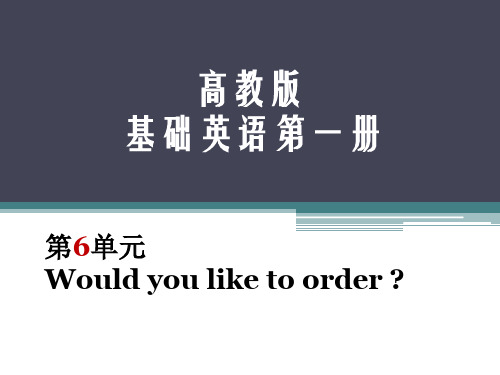
• 3) Ask students to listen again, and fill out the beverage they ordered.
教学方法手段
• 教学方法:Task-based Language Teaching and Situational Language Teaching.
• 教学手段:Multi-media and blackboard
Step 1 Lead-in 6mins
• 1) Ask students to tick the words about the restaurant.
• 3) Ask students to read the dialogue after tape and in pairs.
• 4) Ask students to make a dialogue between customers and waiter/ waitress in group.
Step 4 Conclusion 2mins
教学重点
• 1. Help students consolidate the new words and expressions
• 2. Help students make comparisons.
教学难点
• Help students make a survey to compare restaurants.
the most ~
expensive-more
expensive
大学英语精读第一册电子教案Unit6 Sam Adams, Industrial Engineer
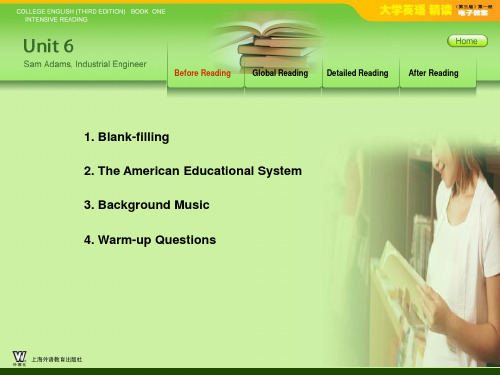
Before Reading
Global Reading
Detailed Reading
After Reading
True or False 1. Sam liked neatness in his childhood. ( T )
2. Like Sam, Sam‟s father would put his tools in order. ( F ) Sam used to organize his father‟s tools. 3. His mother‟s instruction laid a good foundation for Sam to be an efficient industrial engineer. ( F) The qualities Sam had when he was young gave him a good foundation.
Before Reading
Global Reading
Detailed Reading
After Reading
4. Sam said that he was modest enough to take others‟ advice. ( F ) He was a bit bossy. 5. Mr. Hobbs owned a small and efficient factory. The factory was small but inefficient. 6. Sam attended a university in a small town in India. His hometown was in a small town in Indiana. 7. After graduation Sam worked as an advisor for a small factory for a short time. ( T ) ( F) ( F)
interchang1 unit6 教案
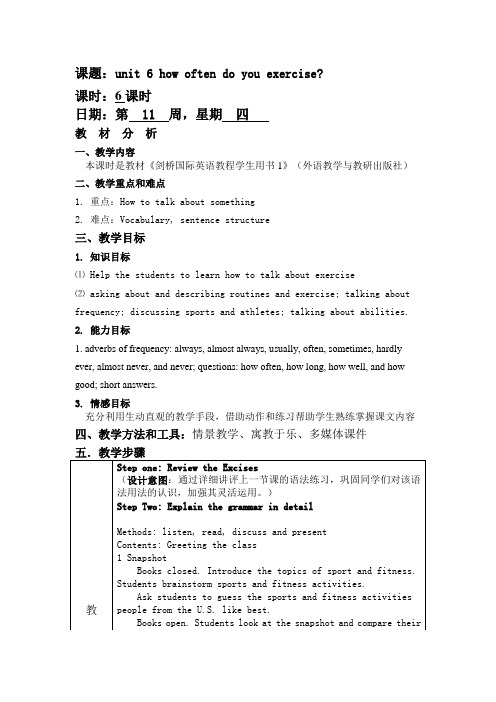
课题:unit 6 how often do you exercise?课时:6课时日期:第11周,星期四教材分析一、教学内容本课时是教材《剑桥国际英语教程学生用书1》(外语教学与教研出版社)二、教学重点和难点1. 重点:How to talk about something2. 难点:Vocabulary, sentence structure三、教学目标1. 知识目标⑴ Help the students to learn how to talk about exercise⑵ asking about and describing routines and exercise; talking about frequency; discussing sports and athletes; talking about abilities.2. 能力目标1. adverbs of frequency: always, almost always, usually, often, sometimes, hardly ever, almost never, and never; questions: how often, how long, how well, and how good; short answers.3. 情感目标充分利用生动直观的教学手段,借助动作和练习帮助学生熟练掌握课文内容四、教学方法和工具:情景教学、寓教于乐、多媒体课件六、板书设计(设计意图:用不同颜色的粉笔让学生对本节课所学的新词、要求掌握的重点一目了然。
同时,教师的板书也是学生很好的笔记样板。
学生在记笔记的过程中也学会了该如何突出重点。
)。
初中英语第一册Unit6教案
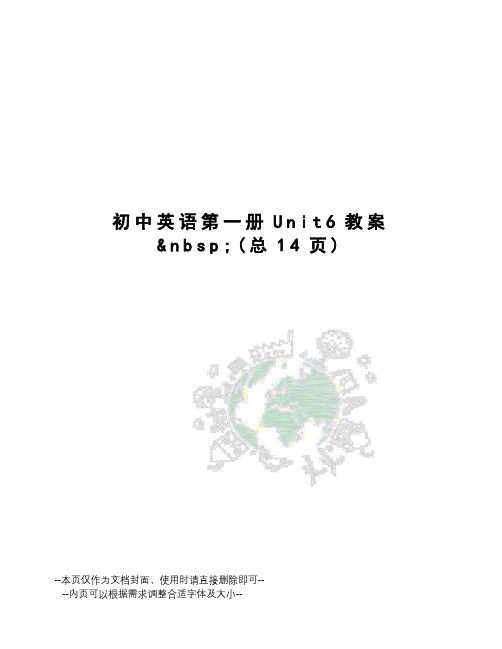
初中英语第一册U n i t6教案&n b s p;(总14页)--本页仅作为文档封面,使用时请直接删除即可----内页可以根据需求调整合适字体及大小--初中英语第一册Unit6教案教学目标与要求一、串记口诀食品水果名称词cake糕饼 egg蛋, apple苹果 pear梨。
Banana译香蕉 ,orange译橙子。
二、学习目标本单元的核心内容是如何表达喜欢和厌恶。
涉及的语法内容还是一般现在时,主要是动词like的一般现在时的陈述句(肯定句、否定句),疑问句及其答语。
三、能力目标1.熟练运用表示喜好和厌恶的日常用语。
进一步学习一般现在时中第三人称单数的动词形式及助动词do/does和don’t/doesn’t的用法,助动词后面加原形动词。
教学重点与难点一、单词导航台n.香蕉【引申】go bananas(美口语)发疯,发狂;banana republic香蕉共和国(指在政治、经济等方面发展缓慢的中美洲小国)。
n.早餐,早点【记忆法】break+fast(旧用法)斋戒后开始进食,所用的第一餐,扩展译为每日的第一餐,即早餐。
【考点】at breakfast早餐时,正吃早饭;have breakfast吃早饭:She doesn’t have breakfa st.她没有吃早饭。
【引申】lunch(午餐);dinner(晚餐);supper(晚餐)。
n.胡萝卜【引申】the stick and the carrot软硬兼施。
n.①雏鸡;②鸡肉【引申】chicken-pox水痘;chickenhearted胆小的。
n.正餐,午饭或晚饭【引申】breafast早餐;lunch中餐;dinner-party晚宴;dining-room餐厅,食堂。
n.蛋,卵【引申】shell蛋壳;white蛋白;yolk蛋黄;egg beater打蛋器;eggcup蛋杯;egg-plant茄子。
n.法语adj.法国的,法国人的n.水果(总称),果实、成果【考点】①Apples, oranges and bananas are fruit.苹果、橘子和香蕉是水果。
jnj Unit6_SectionA(1a-1c)教案
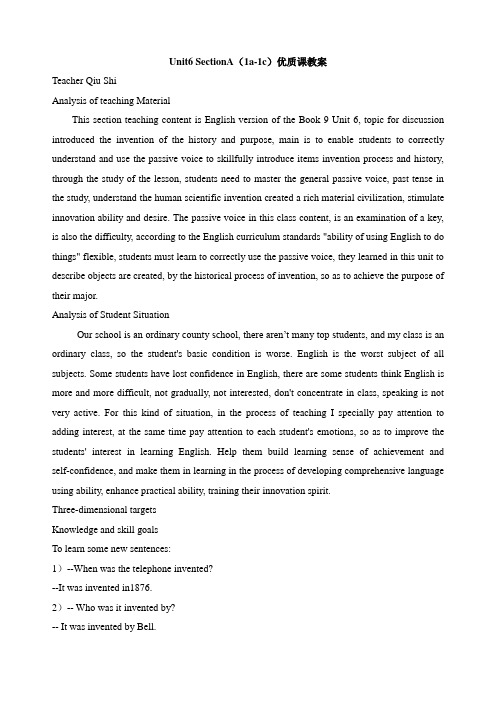
Unit6 SectionA(1a-1c)优质课教案Teacher Qiu ShiAnalysis of teaching MaterialThis section teaching content is English version of the Book 9 Unit 6, topic for discussion introduced the invention of the history and purpose, main is to enable students to correctly understand and use the passive voice to skillfully introduce items invention process and history, through the study of the lesson, students need to master the general passive voice, past tense in the study, understand the human scientific invention created a rich material civilization, stimulate innovation ability and desire. The passive voice in this class content, is an examination of a key, is also the difficulty, according to the English curriculum standards "ability of using English to do things" flexible, students must learn to correctly use the passive voice, they learned in this unit to describe objects are created, by the historical process of invention, so as to achieve the purpose of their major.Analysis of Student SituationOur school i s an ordinary county school, there aren’t many top student s, and my class is an ordinary class, so the student's basic condition is worse. English is the worst subject of all subjects. Some students have lost confidence in English, there are some students think English is more and more difficult, not gradually, not interested, don't concentrate in class, speaking is not very active. For this kind of situation, in the process of teaching I specially pay attention to adding interest, at the same time pay attention to each student's emotions, so as to improve the students' interest in learning English. Help them build learning sense of achievement and self-confidence, and make them in learning in the process of developing comprehensive language using ability, enhance practical ability, training their innovation spirit.Three-dimensional targetsKnowledge and skill goalsTo learn some new sentences:1)--When was the telephone invented?--It was invented in1876.2)-- Who was it invented by?-- It was invented by Bell.3)--What is it used for?--It is used for talking with people.Process and method goals1)Listening and Speaking2)To train the students’ cooperation with their partners.Emotional attitudes and valuesBy learning the time and uses of some modern inventions, and stimulate the emotion that students love to invent. Develop imagination and be good at observing things. In the face of difficulties, we should solve it with a positive attitude, use our imagination, understand the world, and transform the world.Remember: No inventions, no life!Teaching important points1. To learn Passive V oice of the past tense.2. To learn some new sentences:1)--When was the telephone invented?--It was invented in 1876.2)-- Who was it invented by?-- It was invented by Bell.3)--What is it used for?--It is used for talking with people.Teaching difficult points1. How to turn the active voice of the past tense into a passive voice.2. Use the passive voice of the past tense to discuss the inventions’ time and purposes.The teaching method1. Situation teaching method2. Group discussion method3. Intuitive demonstration method4. Cooperation method Teaching resources Multi-Media Cards。
- 1、下载文档前请自行甄别文档内容的完整性,平台不提供额外的编辑、内容补充、找答案等附加服务。
- 2、"仅部分预览"的文档,不可在线预览部分如存在完整性等问题,可反馈申请退款(可完整预览的文档不适用该条件!)。
- 3、如文档侵犯您的权益,请联系客服反馈,我们会尽快为您处理(人工客服工作时间:9:00-18:30)。
(捷进英语1)Unit6-电子教案
教案
课程名称捷进英语综合教程1 课时
班级
专业
教师
系部
教研室
教材《捷进英语综合教程1 教师用书》
Teaching Plan 教学
单元
Unit 6 Feeling Good
单元主题●Helping others
●Optimism vs pessimism
●What makes a hero?
课时
安排
8
教学内容
●Reading for learning
Would You Like to Make a Difference?
●Reading for Doing
Half Full or Half Empty?
●Guided Writing
A Letter of Thanks
●Audio/Video Lab
教学环节主要特色教学活动安排建议
Warm-up
(热身)
This section
introduces
the idea of
feelings and
✧Depending on
the time you
have
available, you
reactions. It does this through a set of adjectives and music clips for students to react to. could extend this into students playing their own music and discussing how the music makes them feel.
Reading for ◆T his
section
starts with
using
pronoun
referents
when
reading to
help
understand
the
organisatio
n of a text.
✧In Task 4 of
Reading and
Understanding
, you could
ask students
to compare
their
translations
with a
partner. Then
ask students
to close their
books and
Readi ng
(阅读)learning It then
encourages
students to
work out
reasons in
the text.
◆V ocabulary
and
Grammar
Students look
at phrases
and
individual
words from
the text.
The grammar
focus looks at
would like to,
like to and
wanted to.
translate them
back into
English.
✧In Vocabulary
Focus, the
three
vocabulary
tasks draw on
the text. Task
1 and Task 3
are also a set
of questions
and so work
well as
pair-work
discussion
◆B eyond the Text Students interpret their own decisions.
tasks.
✧The Grammar Focus part looks at different ways of referring to the past, present and future with quite simple structures. After working through the tasks you would set students a short written or spoken task using these structures to refer to their own desires in
the past
present and
future.
✧Beyond the
Text
encourages
students to
react
personally to
the texts they
have read. It
also practices
the grammar
structure.
Students
could also
think about
and discuss
their own
good deeds.
◆Students ✧This section
Reading for doing read and
answer a
question
naire on
optimism
and
pessimis
m.
should take
less time than
section A as
the text is less
complicated.
They focus on
developing
students’
everyday
reading skills
as they are
reading and
responding to
a
questionnaire.
If time
permits,
students could
create their
own scenario
and options
for others to
choose as an additional question in the questionnaire.
Guided Writing ◆Writing
a letter of
thanks:
(1) Formal
expressio
ns of
thanks
(2) Informal
expressio
ns of
thanks
✧When
checking
Task, 2 you
could
highlight
some of the
other features
of informality
as well as the
vocabulary /
phrases
focused on,
e.g. the
punctuation
and
contractions.
✧With weaker students you might want to show them the model first before they write their email.
Audio/Video Lab
◆Students
watch a
video
showing
an
interview
with
someone
who has
done
something
heroic:
(1) making
✧Write hero
onto the
board and ask
students to
define the
word and to
think of an
example of
one.
✧When you get
to Task 5, you
will probably
need to pause
predictions
(2) dictating
and
answering
questions briefly between each question.
Wrap-up ◆This
section
provides a
quick
review of
the
vocabulary
, grammar,
writing and
theme of
the unit.
◆Tasks
could be set
for
individual
work or
✧For Task 1,
Task 2 and
Task 3 on the
language
work, you
might want to
set them up as
a team game
or class quiz.
✧For Task 4, it
could be set as
small group
discussion
task.
done in
pairs.
课后学习设计
作业◆Finish all the exercises in Unit 6.
◆Read the two texts in this unit again and try
to summarise their contents.
◆Write a letter of thanks to a person who ever
helped you.
课后总结与反思。
